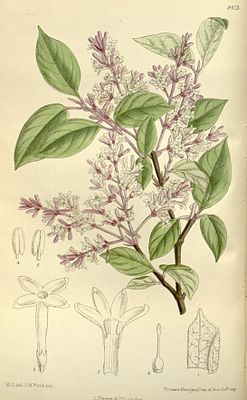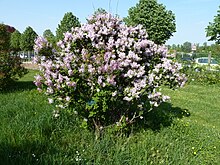Woolly lilac
| Woolly lilac | ||||||||||||
|---|---|---|---|---|---|---|---|---|---|---|---|---|

Illustration of the subspecies Syringa pubescens subsp. julianae |
||||||||||||
| Systematics | ||||||||||||
|
||||||||||||
| Scientific name | ||||||||||||
| Syringa pubescens | ||||||||||||
| Turcz. |
The Woolly lilacs ( Syringa pubescens ) is an upright shrub with purple pink and very fragrant flowers from the family of Olive Family (Oleaceae). The natural range is in China and Korea . The species is rarely used as an ornamental shrub .
description
The woolly lilac is an upright shrub 1 to 4 meters high . The twigs are thin, initially tinged with violet, square or almost stem-round, glabrous, slightly downy hairy, finely hairy or hairy. Terminal buds are missing. The leaves have a 0.5 to 2 centimeter long, bald to hairy stem. The leaf blade is simple, 1.5 to 8, rarely 13 centimeters long and 1 to 6 centimeters wide, ovate, ovate-elliptical to lanceolate or obovate to more or less rounded, blunt, pointed or tapered and with a wedge-shaped to rounded base . The upper side of the leaf is dark green, glabrous to hairy, the underside is also glabrous to hairy or shaggy.
The flowers grow in upright, lateral or rarely terminal bald to hairy panicles 5 to 16 centimeters long and 2.5 to 7 centimeters in diameter . The flowers are sessile or have a short stalk. The calyx is 1.5 to 2 millimeters long. The corolla is 0.8 to 1.8 inches wide, purple, pink, lavender to white. The corolla tube is 0.6 to 1.7 inches long and more or less cylindrical to slightly funnel-shaped. The corolla lobes are ovate to oblong and spread out. The anthers are purple to black, rarely yellow and are located at the throat up to about 3 millimeters below the throat. As fruits 0.7 to 2 centimeters long, long elliptic to oblong-lanceolate, blunt and sharp Korkporen occupied capsules formed.
distribution
The natural range is in China in the province of Gansu , in Hebei , Henan , in the west and northwest of Hubei , in Jilin and Liaoning , in the south of Ningxia , in the east of Qinghai , in Shaanxi , in the west of Shandong , in Shanxi and in Northeast of Sichuan and the Korean Peninsula . The woolly lilac grows on mountain slopes, grassy areas, in forests, thickets and along rivers at altitudes of 300 to 3400 meters on fresh, slightly acidic to slightly alkaline, sandy-loamy to loamy, moderately nutrient-rich soils in sunny to light-shady locations. The species loves warmth and is frost hardy .
Systematics
The wooly Lilac ( Syringa pubescens ) is a kind of the genus of Lilac ( Syringa ) in the family of Oleaceae (Oleaceae). There the genus is assigned to the tribe Oleeae. The species was first scientifically described by Nikolai Turtschaninow in 1840 . The genus name Syringa was chosen by Linnaeus in 1753, previously from around the 16th century the name was used both for the common lilac ( Syringa vulgaris ) and for the European pipe bush ( Philadelphus coronarius ). It was probably derived from the Greek "syrigs", a wind instrument that can be made from the branches of the pipe bush. The specific epithet pubescens comes from Latin and means "downy-haired".
There are four subspecies:
- Julian's lilacs ( Syringa pubescens subsp. Julianae (CK Schneider) MC Chang & XL Chen ) with more or less pedicled branches and inflorescence axes. The calyx is purple and bare. The anthers are up to 1 millimeter inside the corolla tube. The subspecies blooms from May to June, the fruits ripen in October. The distribution area is in the Chinese province of Hubei. The subspecies was described by Camillo Karl Schneider in 1911 as a separate species Syringa julianae and was assigned as a subspecies Syringa pubescens in 1990 .
- Small-leaved lilacs ( Syringa pubescens subsp. Microphylla (Diels) MC Chang & XL Chen ) with more or less petiolate branches and inflorescence axes. The calyx is purple, mostly lightly downy hairy, rarely densely hairy or almost bald. The anthers are up to 3 millimeters inside the corolla tube. The subspecies blooms from May to June, the fruits ripen from July to October. The chromosome number is 2n = 46. The distribution area is in the Chinese provinces of Gansu, Hebei, Henan, Hubei, Ningxia, Qinghai, Shaanxi, Shanxi and Sichuan in forests, on grasslands, along rivers and on mountains at altitudes of 500 to 3400 meters . The subspecies was described by Ludwig Diels in 1900 as a separate species Syringa microphylla and by Camillo Karl Schneider in 1905 as Syringa giraldiana . It was assigned as a subspecies Syringa pubescens in 1990 . In the subspecies, three varieties are distinguished, which differ in the hairiness of the leaves, the color of the corolla and the anthers:
- Syringa pubescens subsp. microphylla var. microphylla with bald to hairy upper surface of the leaf and sometimes finely hairy lower surface towards the base. The corolla is purple, the anthers are purple to black purple.
- Syringa pubescens subsp. microphylla var. potaninii (CK Schneider) PS Green & MC Chang with finely hairy upper surface of the leaf and, especially along the central nerve, finely haired to shaggy hairy lower surface. The corolla is white with a light pink tint. The variety occurs only in Gansu Province.
- Syringa pubescens subsp. microphylla var. flavoanthera (XL Chen) MC Chang with bald to hairy leaf top and sometimes finely hairy underside towards the base. The flowers are white, the anthers yellow. The variety occurs only in Shaanxi in Foping County .
- Spreading lilacs ( Syringa pubescens subsp. Patula (Palibin) MC Chang & XL Chen ) with slightly square, mostly slightly downy-haired to downy-haired branches and inflorescence axes . The anthers are up to 1 millimeter inside the corolla tube. The subspecies blooms from May to July, the fruits ripen from August to October. The distribution area is in Changbai County in Jilin, in Liaoning and in Korea. The subspecies was first described by Iwan Wladimirowitsch Palibin in 1900 as Ligustrum patulum and thus assigned to the genus of the privet . Nakai Takenoshin described it in 1926 as Syringa patula in the genus of lilacs. In 1990 the taxon was assigned as a subspecies Syringa pubescens .
- Syringa pubescens subsp. pubescens with clearly square, mostly bare branches and inflorescence axes. The anthers are 1 to 3 millimeters inside the corolla tube. The subspecies blooms from May to June, the fruits ripen from June to August. The distribution area is in the Chinese provinces of Hebei , Henan , Shaanxi , Shandong and Shanxi on mountain slopes, in thickets and along rivers at altitudes of 900 to 2100 meters.
use
The woolly lilac is sometimes used as an ornamental shrub because of its decorative and intensely fragrant flowers .
proof
literature
- Wu Zheng-yi, Peter H. Raven (Ed.): Flora of China . Volume 15: Myrsinaceae through Loganiaceae . Science Press / Missouri Botanical Garden Press, Beijing / St. Louis 1996, ISBN 0-915279-37-1 , pp. 283 (English).
- Andreas Roloff , Andreas Bärtels: Flora of the woods. Purpose, properties and use. With a winter key from Bernd Schulz. 3rd, corrected edition. Eugen Ulmer, Stuttgart (Hohenheim) 2008, ISBN 978-3-8001-5614-6 , pp. 639-642.
- Jost Fitschen: Woody flora . 12th, revised and expanded edition. Quelle & Meyer, Wiebelsheim 2007, ISBN 3-494-01422-1 , p. 830 .
- Helmut Genaust: Etymological dictionary of botanical plant names. 3rd, completely revised and expanded edition. Nikol, Hamburg 2005, ISBN 3-937872-16-7 (reprint from 1996).
Individual evidence
- ↑ German name according to Roloff et al .: Flora der Gehölze , p. 642 and after Fitschen: Gehölzflora , p. 830
- ↑ a b c d Roloff et al .: Flora der Gehölze , p. 642
- ↑ a b c d Mei-chen Chang, Lien-ching Chiu, Zhi Wei, Peter S. Green: Syringa pubescens , in the Flora of China , Volume 15, p. 283
- ↑ a b c Syringa pubescens. In: Germplasm Resources Information Network (GRIN). United States Department of Agriculture, accessed July 1, 2012 .
- ↑ Exactly: Etymological Dictionary of Botanical Plant Names , p. 625
- ↑ Exactly: Etymological Dictionary of Botanical Plant Names , p. 516
- ↑ a b c German name according to Roloff et al .: Flora der Gehölze , pp. 639–642
- ↑ Mei-chen Chang, Lien-ching Chiu, Zhi Wei, Peter S. Green: Syringa pubescens subsp. julianae , in the Flora of China , Volume 15, p. 283
- ↑ Syringa pubescens at Tropicos.org. In: IPCN Chromosome Reports . Missouri Botanical Garden, St. Louis
- ↑ Mei-chen Chang, Lien-ching Chiu, Zhi Wei, Peter S. Green: Syringa pubescens subsp. microphylla , in the Flora of China , Volume 15, p. 283
- ↑ Mei-chen Chang, Lien-ching Chiu, Zhi Wei, Peter S. Green: Syringa pubescens subsp. patula , in the Flora of China , Volume 15, p. 283
- ↑ Mei-chen Chang, Lien-ching Chiu, Zhi Wei, Peter S. Green: Syringa pubescens subsp. pubescens , in the Flora of China , Volume 15, p. 283
Web links
- Syringa pubescens. In: The Plant List. Retrieved July 1, 2012 .

